Serbian cross
 Serbian tetragrammic cross | |
| Heraldic tradition | Central and Eastern European |
|---|---|
| Governing body | N/A |
The Serbian cross is a national symbol of Serbia, part of the coat of arms and flag of Serbia, and of the Serbian Orthodox Church. It is based on the tetragrammic cross emblem/flag of the Byzantine Palaiologos dynasty, with the difference that in Serbian use the cross is usually white on a red background, rather than gold on a red background (though it can be depicted in gold as well). It is composed of a cross symbol with four stylized letters "S" (С) in Cyrillic on each of its corners, heraldically referred-to as "firesteels", which historically originate as the Greek letters beta (β–Β).
Serbian tradition attributes the letters to Saint Sava, the 12th-century Metropolitan of Žiča and Archbishop of the Serbs, as an abbreviation in Serbian for "Only Unity Saves the Serbs" (Serbian: Само слога Србина спасава; Samo sloga Srbina spasava), which is a traditional cautionary saying. In their origin as letters beta on the cross of the Palaeologan dynasty, they are commonly assumed to represent the motto "Basileus Basileōn, Basileuōn Basileuontōn" (βασιλεὺς βασιλέων, βασιλεύων βασιλευόντων), meaning "King of Kings, Ruling Over Kings".
The double-headed eagle and the cross are the main heraldic symbols which have represented the national identity of the Serb people across the centuries.
Contents
1 Origin
2 History
2.1 Middle Ages
2.2 South Slavic armorials
2.3 Official use
3 Legacy
3.1 Heraldry
3.2 Only Unity Saves the Serbs
4 Examples
4.1 Flags and coat of arms
4.2 Sports
4.3 Other uses
5 See also
6 References
7 Sources
8 External links
9 See also
Origin

The "tetragrammic cross", emblem of the Palaiologos dynasty from the mid-13th century
Crosses with firesteels have been used since Roman times, as symbols, but not as coats of arms or emblems.[1] Some historians connect it with the labarum, the Imperial flag of Constantine the Great (r. 306–337).[1] In the 6th century the cross with four fields (with either letters or heraldry) appear on Byzantine coins.[2] The symbol was adopted by the First Crusaders since the first event, People's Crusade (1096).[2]Michael VIII Palaiologos (1261–1282) adopted the symbol when he resurrected the Byzantine Empire, with the initials (letters β) of the imperial motto of the Palaiologos dynasty: King of Kings, Ruling Over Kings (βασιλεὺς βασιλέων, βασιλεύων βασιλευόντων; Basileus Basileōn, Basileuōn Basileuontōn).[2] It was used in flags and coins.[2] The symbol appear on the Imperial flag divellion (διβελλιον) used in front of all other banners, recorded by Pseudo-Kodinos (fl. 1347–68) wrongly[3] as "a cross with firesteels" (σταυρον μετα πυρεκβολων),[4] and depicted in the Castilian Conosçimiento de todos los reynos atlas (c. 1350).[2][5] As Alexander Soloviev writes, the use of letters in western heraldry is nonexistent.[3]
History
Middle Ages
The oldest preserved historical source of the cross is from the Dečani oil-lamp (Dečanski polijelej), which was a gift to King Stefan Milutin (r. 1282–1321), the ktetor (founder) of Visoki Dečani, now preserved at the Monastery of Prohor Pčinjski.[6]
Stojan Novaković argued that the recorded use of the Serbian cross, as a national symbol, began in 1397, during the rule of Stefan Lazarević.[7] It was possibly derived from the Dečani polijelej.[7] Serbian historian Stanoje Stanojević argued that it entered its use in 1345, with Stefan Dušan's elevation to Emperor.[8] In the Middle Ages, both the "Greek style", with closed fire-steels (β–B), and the "Serbian syle", with open fire-steels (C-S), were used in Serbia.[3]
A 1439 map by Gabriel de Vallseca used both the Serbian cross and eagle when depicting Serbia.
South Slavic armorials

The coat of arms of Serbia in the Fojnica Armorial (17th century), based on the 1595 design in the Korenić-Neorić Armorial.
In South Slavic heraldic sources (also known as "Illyrian Armorials"), the Serbian cross is found in the Korenić-Neorić Armorial (1595), which shows the coat of arms of Serbia (Svrbiae) as a white cross over a red background, with four firesteels, also depicting the Mrnjavčević noble house with the same design, with inverted colours and the Serbian eagle in the center of the cross. According to Mavro Orbini (1607), it was used by Vukašin Mrnjavčević (King, 1365–1371) and Lazar Hrebeljanović (Prince, 1371–1389).[8] Next, it is found in the Belgrade Armorial II (ca. 1600–1620), the Fojnica Armorial (between 1675–1688), the Armorial of Stanislaus Rubcich (ca. 1700), and Stemmatographia (1741), while still continuing to be used in foreign heraldic sources.
Official use
The Metropolitanate of Karlovci, established in 1691, adopted it in its seal.
After the Serbian Revolution, the Serbian cross then appeared on all official Serbian coats of arms, except the Serbian coat of arms adopted in 1974, which had the cross removed, leaving four stylized S; this was done symbolically by the Yugoslav government to "socially curtail and politically marginalize religious communities and religion in general".[9]
During WWII, The Serbian cross was used in the Nazi backed puppet government, Government of National Salvation Flag (1941–1944).
Miloš Obrenović adopted the Serbian cross as the military flag when forming the first units of the regular army in 1825.[10]
Legacy
Heraldry
The double-headed eagle and the cross are the main heraldic symbols which represent the national identity of the Serbian people across the centuries.[11]
The Serbian cross symbol has been frequently used in Serb heraldry.[12]
Only Unity Saves the Serbs
The Serbian tradition attributes the symbol to St. Sava, 12th century metropolitan of Žiča and Archbishop of Serbs, creation of the popular motto from those four letters, Only Unity Saves the Serbs (Serbian: Само слога Србина спасава/Samo sloga Srbina spasava).[13][better source needed]
The memorial park in Tekeriš, where the first battle of World War I was fought, the monument has "18-VIII-1914" and Samo sloga srbina spasava inscribed.
A monument in Šamac, Republika Srpska, Bosnia-Herzegovina for the Serbs who fought and died in the Bosnian war, has the Serbian eagle in the center, the years which the war occurred (1992-1995) and Samo sloga srbina spasava on the left and right sides.
Examples
Flags and coat of arms

State flag of Serbia

Traditional flag of Vojvodina province

Flag of the Serbian Orthodox Church

Coat of arms of Serbia

Traditional coat of arms of Vojvodina province
- Historical coats of arms and flags

Flag and coat of arms of the Serbian Empire, Gabriel de Vallseca (1439).

Serbia, Belgrade Armorial II (ca. 1600–1620)
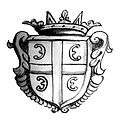
Coat of arms of Serbs (17th century), ed. of Mavro Orbini's Regno degli Slavi (1601)

Coat of arms of the Metropolitanate of Karlovci (1713)
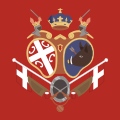
Flag of the Revolutionary Serbia and Topola, 1804
Government seal
(Revolutionary Serbia, 1805–1813)

Coat of arms of Prince Miloš I (1819)

Principality of Serbia
(1835–1882)

Serbian Vojvodina
(1848–1849)

Civil flag of Serbia (1869)

Coat of arms of Prince Peter I (1903–1918)

Kingdom of Serbia (1882–1918)

Kingdom of Yugoslavia (1918–1944)

Government of National Salvation (1941–1944)

Socialist Republic of Serbia (1947–1992) and Republic of Serbia (1992–2004)
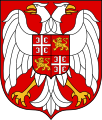
Federal Republic of Yugoslavia (1992-2003) Serbia and Montenegro (2003–2006)

Republic of Serbia
(2004–2010)
- Cities and municipalities in Serbia

Srpska Crnja

Kragujevac

Ljubovija
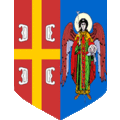
Aranđelovac

Rača

Barajevo

Surdulica

Zvezdara
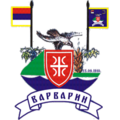
Varvarin

Vračar

Voždovac
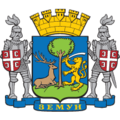
Zemun

Mladenovac
- Cities and municipalities in Republic of Srpska

Banja Luka (1992-2017)

Nevesinje
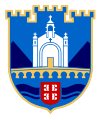
Višegrad

Prijedor (1992-2013)

Gradiška

Laktaši

Istočno Novo Sarajevo

Šipovo

Kotor Varoš

Srbac
- Cities and municipalities elsewhere

Staro Nagoričane, Macedonia
Sports

Logo of the Olympic Committee of Serbia
Other uses
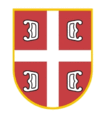
Shoulder patch on uniforms of the Serbian Armed Forces

Serbian vehicle registration plate

Logo of the Serbian Academy of Sciences and Arts
See also
- Coat of Arms of Serbia
References
^ ab Atlagić 1997, p. 1.
^ abcde Atlagić 1997, p. 2.
^ abc Atlagić 1997, p. 3.
^ Palavestra 1998, p. 1.
^ "Other Byzantine flags shown in the "Book of All Kingdoms" (14th century)". Flags of the World. Retrieved 07-08-2010. Check date values in:|accessdate=(help).mw-parser-output cite.citation{font-style:inherit}.mw-parser-output .citation q{quotes:"""""""'""'"}.mw-parser-output .citation .cs1-lock-free a{background:url("//upload.wikimedia.org/wikipedia/commons/thumb/6/65/Lock-green.svg/9px-Lock-green.svg.png")no-repeat;background-position:right .1em center}.mw-parser-output .citation .cs1-lock-limited a,.mw-parser-output .citation .cs1-lock-registration a{background:url("//upload.wikimedia.org/wikipedia/commons/thumb/d/d6/Lock-gray-alt-2.svg/9px-Lock-gray-alt-2.svg.png")no-repeat;background-position:right .1em center}.mw-parser-output .citation .cs1-lock-subscription a{background:url("//upload.wikimedia.org/wikipedia/commons/thumb/a/aa/Lock-red-alt-2.svg/9px-Lock-red-alt-2.svg.png")no-repeat;background-position:right .1em center}.mw-parser-output .cs1-subscription,.mw-parser-output .cs1-registration{color:#555}.mw-parser-output .cs1-subscription span,.mw-parser-output .cs1-registration span{border-bottom:1px dotted;cursor:help}.mw-parser-output .cs1-ws-icon a{background:url("//upload.wikimedia.org/wikipedia/commons/thumb/4/4c/Wikisource-logo.svg/12px-Wikisource-logo.svg.png")no-repeat;background-position:right .1em center}.mw-parser-output code.cs1-code{color:inherit;background:inherit;border:inherit;padding:inherit}.mw-parser-output .cs1-hidden-error{display:none;font-size:100%}.mw-parser-output .cs1-visible-error{font-size:100%}.mw-parser-output .cs1-maint{display:none;color:#33aa33;margin-left:0.3em}.mw-parser-output .cs1-subscription,.mw-parser-output .cs1-registration,.mw-parser-output .cs1-format{font-size:95%}.mw-parser-output .cs1-kern-left,.mw-parser-output .cs1-kern-wl-left{padding-left:0.2em}.mw-parser-output .cs1-kern-right,.mw-parser-output .cs1-kern-wl-right{padding-right:0.2em}
^ Atlagić 2009, p. 182.
^ ab Atlagić 1997, p. 4.
^ ab Atlagić 1997, p. 5.
^ Mitja Velikonja (2003). Religious Separation and Political Intolerance in Bosnia-Herzegovina. Texas A&M University Press. pp. 187–. ISBN 978-1-60344-724-9.nations (in a symbolical sense as well, for example, by removing the cross from the Serbian coat of arms but keeping the four stylized esses), and to socially curtail and politically marginalize religious communities and religion in general.
^ Posebna izdanja 295. SANU. 1957. p. 133.
^ Atlagić 2009, p. 180.
^ Anarheologija Slika 5: Srpski štit, grb Despotovine od početka XV veka.
^ Christopher Merrill (2001). Only the Nails Remain: Scenes from the Balkan Wars. Rowman & Littlefield. p. 161. ISBN 978-0-7425-1686-1.
Sources
Atlagić, Marko (1997). "The cross with symbols S as heraldic symbols" (PDF). Baština. 8: 149–158. Archived from the original (PDF) on May 21, 2013.
Atlagić, Marko (2009). "Određivanje nacionalnih heraldičkih simbola na primjeru Srba i Hrvata" [Étude des symboles nationaux héraldiques à l' exemple des Serbes et des Croates] (PDF). Zbornik radova Filozofskog fakulteta u Prištini. 39: 179–188.
Atlagić, Marko (2007). "Dečanski polijelej" (PDF). Baština. 22: 245–250.
Milićević, Milić (1995). Grb Srbije: razvoj kroz istoriju. Službeni glasnik.
Palavestra, Aleksandar (June 1998). "O ocilima" (PDF). Glasnik SHD (in Serbian). Archived from the original (PDF) on 2013-10-29.
Solovjev, Aleksandar Vasiljevič (1958). Istorija srpskog grba. Srpska misao.
Stanojević, Stanoje (1934). "O srpskom grbu". Iz naše prošlosti. Belgrade: Geca Kon A. D. pp. 85–90.
External links
Борис Субашић (16 March 2014). "Србија сачувала симболе Византије" (in Serbian). Novosti.
See also
| Wikimedia Commons has media related to Serbian cross. |
- Flag of Serbia
- Coat of arms of Serbia
















































